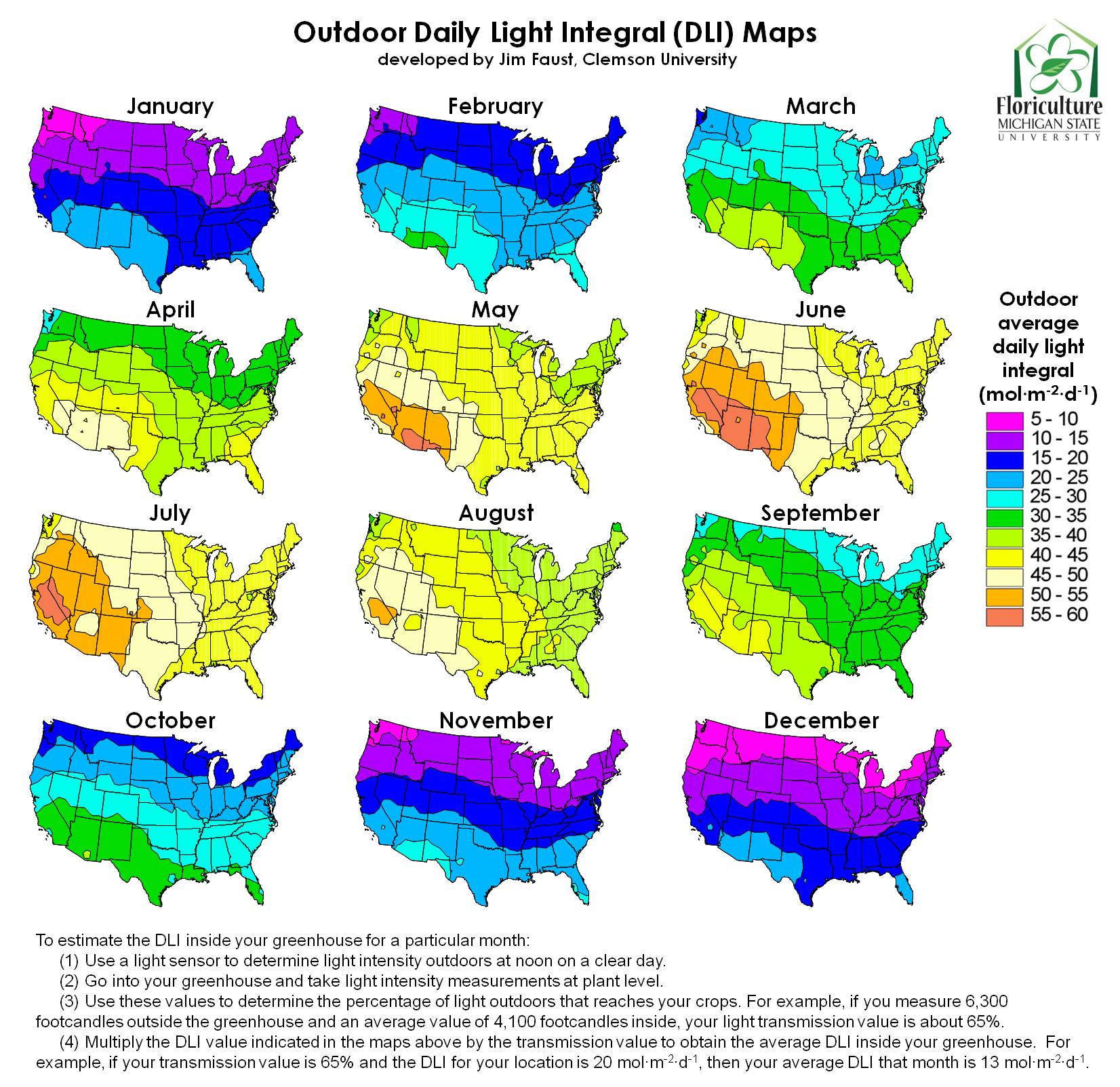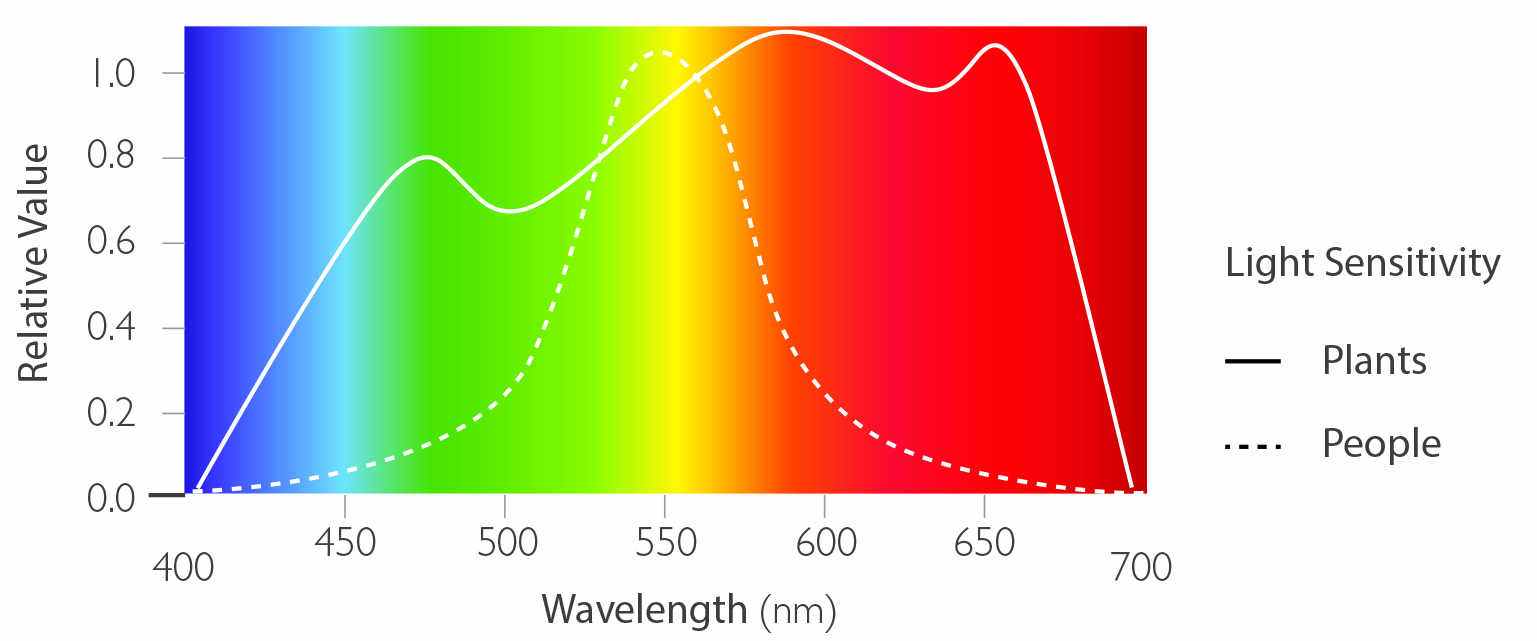Lighting Glossary
Created by our team of experts, the P.L. Light Systems glossary provides an overview of common terms related to supplemental lighting. Here, we aim to further growers’ understanding of these terms in order to make an informed decision when purchasing horticultural lighting.
Daily Light Integral (DLI): Refers to the cumulative amount of PAR light received in a 1 square meter (10.8 sq. ft.) area each day represented as mol/m2/day – it is a function of light intensity and duration. DLI has become an important tool for managing the light environment to optimize crop growth. A grower can think of DLI as the plant’s daily light dose. DLI is positively related to photosynthesis, growth rate, and overall plant productivity. The units for DLI are similar to that of PPFD. However, rather than being an instantaneous measurement, DLI extends over an entire day – much like how you would measure rainfall over a day. DLI naturally changes with the seasons, leading to higher DLIs in the summer and lower values in the winter. DLI can be increased with the use of supplemental lighting during low light times of the year.
DLI Map: Daily Light Integral Maps were developed in collaboration by Joanne Logan, associate professor in Biosystems Engineering and Soil Science at the University of Tennessee Institute of Agriculture, and James Faust, associate professor at Clemson University, to provide the average outdoor daily light integral (DLI) throughout the year in the United States. These maps are valuable for estimating how much supplemental light you will need to reach your desired DLI. The DLI inside the greenhouse will obviously be lower, and the transmission percentage will depend on factors such as glazing, structure, shade cloth, etc. To estimate the DLI inside your greenhouse, you can multiply the outdoor DLI by the transmittance rate of your glazing.
An interactive DLI map can be found here.

High-Intensity Discharge (HID) lamps use an electric arc between two electrodes to produce an intensely bright light. Mercury, sodium, or metal halide gas acts as the conductor. Lamps in this category are high-pressure sodium (HPS), metal halide (MH), and ceramic metal halide (CMH).
Ingress Protection (IP) is a rating given to electronic devices indicating their level of protection against dust, water, and vapor penetration. IP ratings are written in the format IPXY. “X” is the light fixture’s protection against the penetration of dust and other particles and can be any number between 0 and 6, with 0 being the least protected and 6 the most protected. “Y” is the light’s protection against water and moisture penetration. Y ranges from 0 to 8, with 0 being the least protected and 8 being the highest protected.
LED Lifetime data (LxxBx) indicates the technical lifespan of the product based on scientific laboratory extrapolated calculations. For example, for an LED luminaire with a lifetime of L90B5, the L-value indicates the amount of light output deterioration expected after some time. If the light source has a lifespan of 50,000 burning hours and an L90 value, this means that 90% of the light output is expected to still be available after 50,000 burning hours. B5 indicates that 5% of the luminaires can be below 90% of the output within 50,000 hours and still meet the threshold of acceptability.
Light Emitting Diodes (LEDs) are semiconductor devices that produce visible light when an electrical current passes through them. LEDs are a type of Solid State Lighting (SSL).
Light Intensity refers to the amount of light available to the plant and can influence yield, taste, and quality. In general, as intensity increases, photosynthesis and crop growth increase up until a certain point―known as the saturation point. Past this point, additional light intensity will not increase plant growth.
Light Quality refers to the colors/wavelengths of the electromagnetic spectrum. Light quality, also known as photomorphogenesis, influences plant morphology and development. These responses can include germination, flowering, and leaf expansion.
Lumens/Lux are units of measurement based on how humans perceive light intensity. Since humans are more sensitive to green light and not blue and red (which are the colors plants respond most strongly to), these measurements do not accurately measure light within the PAR region and should not be used as metrics for horticultural lighting.
Micromole: A micromole (µmol) is one-millionth of a mole (1×10-6). The measurement µmol/m2/s is a measurement that counts the number of µmol photons in the PAR range that reaches one square meter each second.
Mole: A mole is a unit for measuring very small entities such as atoms, molecules, and photons. A mole represents a very large constant number (6.02 x 1023)
Night Interruption (NI) Lighting is the practice of providing low-intensity (~2 µmol/m2/s) photoperiodic lighting to plants during the middle of the night. The plants will not perceive a long night but a short night (long day) instead. NI lighting is typically used during the middle of the night because that’s when plants are most sensitive to light. NI lighting can be used to promote flowering in long-day plants or keep short-day plants in a vegetative growth phase.
Photosynthetically Active Radiation (PAR) represents the wavebands of light between 400-700 nanometers (nm) that drive photosynthesis. The reason PAR falls between these wavelengths is that photosynthetic pigments absorb light energy within this range. For example, chlorophyll in the leaf has an absorption pattern that peaks in the blue (400-500nm) and red (600 700nm) wavelengths. Increases in PAR light will enhance the light reaction of photosynthesis until it reaches a saturation point. Beyond that point, any further increases in PAR will not result in more photosynthesis. This will vary by plant species, as shade plants can harvest PAR more efficiently at low light levels but less efficiently at high levels compared to sun plants.
Photoperiod is the daily hours of light and darkness that a plant receives. Many plants have a flowering response that corresponds to the number of light hours in 24 hours, referred to as photoperiod. However, it is the uninterrupted period of darkness that controls the flowering responses in plants. Plants can be divided into short–day, long–day, and day-neutral varieties. Short- and long-day species have developmental responses relative to the lengths of light and dark periods. For example, a chrysanthemum plant (a short-day plant) will only initiate flowering when days are short and nights are long (more than 12 hours).
Photosynthetic Photon Efficacy (PPE) is the PAR output of a light source measured in micromoles per second divided by the input power (watts) to produce that light. The higher the PPE value, the more effective it is at converting electricity into photosynthetic photons. PPE is measured in micromoles per Joule (µmol/J) and provides insights into how efficient a light source is at converting watts into photons. For example, the NXT2 double-ended HPS luminaire measures an efficacy at 2.1 µmol/J, whereas the HortiLED Top 2.0 RW(MB) has an efficacy of 3.3 µmol/J.
Photosynthetic Photon Flux (PPF) represents the total amount of PAR produced by a light source per second, expressed as micromoles per second (μmol/s). PAR is an important measurement when comparing luminaires.
Photosynthetic Photon Flux Density (PPFD) is an instantaneous (spot) measurement of the amount of PAR that is distributed to and arrives at the crop canopy. PPFD is measured in micromoles per square meter per second (μmol/m2/s). This is important because you need to know how much light is being distributed at the crop level from the sun and/or grow lamps to ensure plants are receiving the correct amount of light to hit your target DLI.
Photon: A particle of light energy.
Sole Source Lighting is a term to describe the lighting of plants that do not receive light from the sun. This generally refers to warehouses and other indoor applications. It is therefore only artificial lighting that provides the sole source of light for plant growth and development.
Supplemental Lighting is used in greenhouses to increase crop production during periods of low light intensity to increase plant growth. In supplemental lighting applications, it is both the sun and the luminaire that provide light to the plants.


